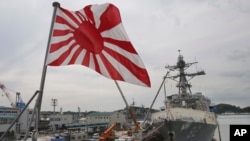South Korea’s Jeju Island welcomed nearly 20 fleets from more than ten countries as it kicked off a five-day international naval review. However, the ghost and painful memory of World War II atrocities appeared this week when Japan, a key U.S. ally in the region and less than 1,000 kilometers away, elected to skip this year’s event after Seoul requested ships from the Japanese Maritime Self-Defense Force not to fly their naval ensign, the 16-ray rising sun flag. Despite Tokyo’s absence from the event, the dispute over the flag is expected to continue between the two countries even after its conclusion.
Two atrocities appeared this week when Japan, a key U.S. ally in the region and less than 1,000 kilometers away, elected to skip this year’s event after Seoul requested ships from the Japanese Maritime Self-Defense Force not to fly their naval ensign, the 16-ray rising sun flag. Despite Tokyo’s absence from the event, the dispute over the flag is expected to continue between the two countries even after its conclusion.
South Korea and other Asian countries strongly associate the rising flag with Japan’s aggression during the 20th Century. Some even go as far as to link the flag to various atrocities and consider it a lasting symbol of World War II.
South Korea’s navy had asked all nations participating to display their national flags and the South Korean flag on their vessels. Some viewed that request as a way to prevent Japanese vessels from flying the kyokujitsuki, or rising sun flag.
Japanese officials told the Associated Press it is mandatory for Japan’s naval ships to fly the ensign under domestic laws and only commercial ships fly the “hinomaru,” or national flag, to differentiate them.
Japanese Chief of Staff Katsutoshi Kawano said the flag was a matter of pride for the Maritime Self-Defense Force sailors and regretted the impasse with Seoul over its use. Japan also refutes the idea that the naval ensign is a symbol of war.
Flag evokes deeply rooted resentment
South Korean Prime Minister Lee Nak-yeon highlighted the nation’s antipathy toward the flag earlier this month. “Japan must carefully consider the effect that the Rising Sun Flag has on the Korean people, who remember the pain of colonial rule," he said in an October 1 cabinet meeting.
Furthermore, the hostility toward the naval ensign is not limited to political issues, but manifests throughout South Korean pop culture. In 2016, K-pop singing idol Tiffany (from the group Girl’s Generation) was removed from a television variety show because she used a rising sun flag emoji in an Instagram post celebrating Liberation Day, the August 15th holiday marking Japan’s World War II surrender. The emoji’s use immediately evoked public outrage and the network announced Tiffany’s departure three days later.
But it is not only the flag itself that elicits strong reactions. In some cases, just the radial pattern design of the flag is enough. Earlier this year, Nike canceled the release of a shoe adapting the pattern design and local brewery Hite discontinued a special edition beer label with it, even though the featured colors were purple and blue.
Ewha Womans University industrial design professor Cho Young-sik explained why the pattern is so readily seen, even though it has long-drawn resentment.
“Sunrise itself is generally considered positive. Although the intensity of image limits its direct utilization in fashion design or interface design, its concept [radial pattern] is commonly adopted in brand design as a motif,” he said.
Cho went on to say that that the design’s perceived meaning also varies between cultures, noting the design concept delivers different feelings depending on the color combinations used.
“Unlike the Japanese flag, yellow and orange are frequently used in this pattern in the Western culture,” he added.
From an aesthetic perspective, Cho said, “The image is effective in getting public attention, with an intense color contrast of red and white,” saying it’s more effective at transmitting Japan’s national identity than its national flag.
Renewed push for a legislative ban
On October 1, South Korean legislator Shin Yong-hyeon proposed a bill in the National Assembly aiming to prohibit the rising sun design be used in South Korea.
The “Rising Sun Flag is equivalent to the Häcken Kreitz (Nazi party flag used during World War II) in South Korea. It is a symbol of Japanese past military aggression,” Shin’s spokesperson told VOA.
A similar bill was introduced in 2016, but never passed. The latest iteration is more comprehensive and includes adaptive designs. That piece of legislation has garnered increased support as diplomatic rows continue over longstanding issues such as the comfort women and Dokdo, a set of small islets also claimed by Japan and known as Takeshima or internationally as the Laincort Rocks).
Tokyo defends its persistent use, saying the radial pattern of the rising sun has been used a long time, dating back to the Edo period (1603-1868). The kyokujitsuki appeared as the official naval ensign in 1889 and was registered with the International Maritime Organization in 1954, the same year the Japanese Maritime Self-Defense Force was established.
Yang Gi-ho, a Japanese studies professor at Sungkonghoe University, says to the Japanese, the flag’s design has an entirely different interpretation than it does in Korean society.
“It traditionally symbolizes fertility and abundance in Japanese culture,” Yang said, noting that some companies incorporate it into their branding. Among those is the Asahi Shinbum newspaper.
He said that while it is his view that it is not appropriate to ban the flag in South Korea, Japanese officials should consider national sentiment in South Korea as both counties try to improve their relationship and move forward.







